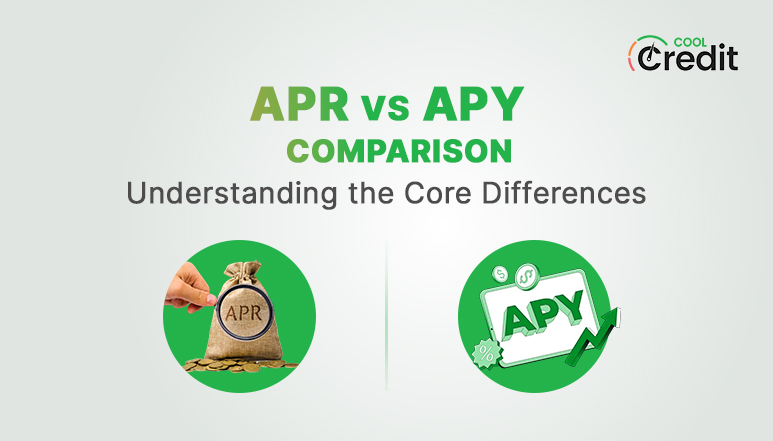
APR vs APY Comparison: Understanding the Core Differences
Whether you are considering taking a loan or diving into investing, you may have come across terms like “APR” and “APY”. While these terms may sound similar, they mean completely different things.
APR vs APY Meaning: ‘Annual Percentage Rate', known as APR for short, represents the total cost of borrowing you incur when you borrow money. On the contrary, ‘Annual Percentage Yield', aka APY, is the money that you earn from your investments or savings. This can include the interest you earn on your savings or dividends you get by investing.
So in simple words, APR is what you pay in the form of interest, closing costs, and other expenses related to taking loans. APY is the ‘annualized rate of return’ you can expect to earn on your cash investments or savings accounts.
Let’s dive deeper into what makes APR and APY useful and clarify the differences between the two.
Your Credit, Our Priority! Start improving your credit score now
Get StartedWhat Is APY?
Annual Percentage Yield (APY) is the amount that you’ll earn over a year on the money that you choose to save in a bank account, invest in stocks, or any other money-making securities. Generally, a higher APY means more money. It’s a crucial element to consider when you venture into any new investments.
Applies to:
- Savings Accounts: Earns interest over time and typically have lower APYs.
- High-Yield Savings Accounts: Offered by banks, these accounts provide higher APYs than regular savings accounts.
- Certificates of deposit (CDs): Offered by traditional banks. You can deposit a specified sum of money for a fixed period (i.e., 6 months, 1 year, or 5 years) in exchange for a higher APY.
- Investment Accounts: For instance, stocks, bonds, mutual funds, and ETFs allow you to put your money to work. This is a type of risk-prone investment that may be ideal for experienced traders.
- Interest-Bearing Checking Accounts: Some banks may also offer higher APYs to individuals on the condition of maintaining a high balance on their checking account.
- Treasury Bonds: These are government-backed securities that earn high interest over a fixed period for long-term gains.
- Interest-Bearing Financial Products: APY also applies to a wide range of interest-bearing financial accounts.
Why It Matters:
- A higher APY helps grow your investments faster
- It helps build a profitable investment portfolio
- Knowing the APY helps make informed financial decisions when comparing different investment opportunities
- It includes compound interest, which contributes to long-term financial sustainability and wealth expansion.
What Is APR?
APR is the actual cost of obtaining any lines of credit, which includes more than just the initial interest rate. In fact, sometimes credit cards or medical credit cards may come with 0% interest for a specified time but overall a high APR after the promotional period. Thus, this gives you a more accurate image of what it is costing you to acquire debt.
Applies to:
- Credit Cards: High APR is usually applied to credit card purchases, cash advances, and balance transfers.
- Mortgage: Low to high APR is applied to mortgage debt depending on your creditworthiness.
- Personal Loans: When you apply for any type of line of credit including personal loans, an APR is applied which often varies based on your credit scores.
- Auto Loans: When you need financing for a car or use your car to get financing on bad credit, APR is applied
- Short-Term Loans: Any short-term loans, such as payday loans, often carry high APRs.
- Financing: APR is also applicable when you apply for financing for medical or other services. However, some BNPL financing and payment plan options may come with 0% APR for a specific promotional period, i.e., 3 months, 6 months, or a year.
Why It Matters:
- Helps determine the total cost of borrowing
- Helps compare the rates from different lenders before taking on debt
- Comparing costs of home loans, car loans, and personal loans to find the most affordable option
- Determines how much interest you’ll owe on your credit cards
- Knowing the APR helps with making a strategy for effective debt management.
Difference Between APR and APY
APR (Annual Percentage Rate) and APY (Annual Percentage Yield) both serve different purposes and thus may impact you in different ways:
| Criteria | APY | APR |
| Purpose | Determines earnings from savings and investments in the form of returns over a year | Determines the true cost of borrowing over a year |
| Ideal range | High APY is ideal as it reflects higher returns on investments | Low APR is ideal, as this reflects a lower cost of borrowing money, more favorable terms, and better financial standing. |
| Application | Applied on savings, investment accounts, cash deposits, bonds, etc. | Applied on mortgages, loans, credit cards, etc. |
APR vs APY: Impact Based on Credit Standing
How APR Affects You:
- Higher Credit Score → Lower APR
Lenders offer better rates when your credit scores are high, as they consider people with good credit standing as low-risk borrowers. Thus, it becomes easier to get quick approval for loans on desirable terms.
- Lower Credit Score → Higher APR
If your credit is poor, this means the lender views you as a high-risk borrower, so you may face difficulty getting loan approval, plus, you’ll need to pay a higher interest rate.
How APY Affects You:
It may not be directly related to your credit score, but it can positively impact your credit standing.
- Higher Credit Score → Easier Access to High-APY Accounts
Higher credit scores reflect a strong financial standing, so when you are looking to invest, banks may offer exclusive deals or premium offers on savings and investment products to customers with a high credit score.
- Lower Credit Score → Limited Access to High-APY Accounts
Though it may not always be a requirement, some high-yield investment accounts may set their eligibility criteria based on banking history or financial standing. For instance, for Cash Deposits (CDs) or high-APY accounts offered by private banks like Goldman Sachs, JPMorgan Chase & Co, Wells Fargo, etc.
Empower Your Credit Score! – Take the first step towards better credit today.
Install the AppConclusion
Before making financial decisions regarding acquiring debt or investing in financial securities or savings accounts, it is important to check and compare the APR and APY rates. Plus, by working on improving your credit standing, there is a better chance of getting a low APR and a high APY. A good credit score would put you in a favorable light when applying for credit applications or investment accounts. For this, you need favorable credit activity and monitor your credit reports regularly.
To make credit improvement easier, you can resort to a DIY credit improvement app like CoolCredit. You can monitor credit scores in real-time, along with an AI-powered analysis of the credit report that points out any negative items while highlighting the steps to improve your scores.
FAQs
Q: Should APR Be High Or Low?
A: A low APR would benefit you when applying for any loans, as this implies you will incur a lower cost when borrowing money. It’s possible when you have “Very Good” or “Excellent” credit scores. However, a high APR would translate to a high cost when borrowing money, which can cause more financial strain. So, APR should ideally be low.
Q: Should APY Be High Or Low?
A: A high APY is ideal, as the higher it is, the more you will earn. Hence, when investing or starting a savings account, it’s a critical element to consider how frequently the interest compounds on your investment or saving account. The more frequently it happens, the higher the APY will be.
Q: Is Compound Interest Relevant to APR or APY?
A: Compounded interest is factored in to calculate APY. It helps predict your return on investment. Hence, it is relevant for APY; however, APR does not take into account compound interest.
Q: What Are the Differences Between APY vs. Interest Rate?
A: The interest rate is the basic percentage a financial institution pays on your balance. However, APY shows your true yearly earnings, including the compounding interest, which gives a more accurate measure of how much you will actually earn.
Q: How Is APR Different from Interest?
A: APR includes more than just the interest rate. It also includes the associated costs, like closing costs, lender fees, and other additional costs to provide the annual average rate. Hence, it presents a clearer picture of the cost of borrowing than the interest rate alone.
Q: Which Is More Important When Applying for a Loan—APR or APY?
A: APR tells you how much it truly costs to obtain credit; hence, it is a critical factor when applying for any lines of credit. On the other hand, APY is relevant when you are looking to invest your money in stocks or other securities, so it may not be relevant in that instance.







